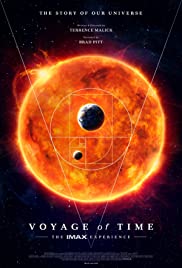
VOYAGE OF TIME: THE IMAX EXPERIENCE
US, 2016, 45 minutes, Colour.
Narrated by Brad Pitt.
Directed by Terence Malick.
This is a 45 minutes IMAX experience that invites its audience to surrender to it. (It should be noted that writer-director, Terence Malick, produced two versions of his Voyage of Time. The first is a feature length documentary film narrated by Cate Blanchett. The second is this film, a briefer IMAX experience, narrated by Brad Pitt.)
Audiences will remember the cosmic sequences in the award-winning The Tree of Life. In that fiction film, Malick was exploring the human family, love and conflicts, but tracing it back to the history of the evolving world and evolving humans. This is the presupposition here, focusing on a little girl on a building estate, addressing the film as a letter to her, inviting her to wonder about the world in which she finds herself.
Wonder is probably a keyword for this film. (Another of Malick’s films is titled, To the Wonder.)
It is a powerfully visual experience, especially on the vastness of the IMAX screen. With spectacular special effects, suggestions are made about the void of the universe, the Big Bang, the explosions, an expansion of energy. Contemporary landscapes from such countries as Iceland and Chile provide visual images that suggest these primaeval times. Gradually, there is the evolution of basic life forms, the development of these forms, life in plants and then the evolution of live creatures with bodies, and then consciousness.
Particularly striking, literally, is the arrival of the meteor that transforms the world, setting back a lot of the geographical and geological evolution, almost starting again.
Within the short space of the film, the narrative moves to primitive human beings, hunting, community, again showing developing consciousness. The transition to the contemporary world, the skyscraper modern city, the night views of car lights racing through the city streets comes more quickly than might have been anticipated.
So, on the level of the visuals, the film is something of a cinema poem.
The audience is conscious throughout the film of the orchestral music as well of the religious choral music – and quite a list of credits to particular pieces at the end of the film, ranging from Bach to Arvo Part.
For some audiences, it is the narrative which might cause some difficulties. It is spoken with many pauses, sometimes hushed words, sometimes a reverential and awestruck tone, by Brad Pitt.
This is where many scientists might baulk at this poetic interpretation of evolution, the quick sketching in of aspects of the universe and then the quick move to the planet, Earth. They might also baulk at the generalisations, wanting more precise language and observations. And the danger of this kind of narrative is that it becomes so solemn that it seems more than a touch pretentious. There was something of this difficulty for many audiences for The Tree of Life and its cosmic overview and its insertion into the contemporary family story.
Obviously, it would be interesting to make comparisons with the full-length documentary and to discover what has been omitted (almost the length again of this IMAX experience) and to hear the dialogue spoken by Cate Blanchett.
In the meantime, for those who surrender to its images, it is a visual poem that raises so many questions about infinity and finitude, the origins of the universe, how life came to be, what were the first experiences of death, how did consciousness evolve…?